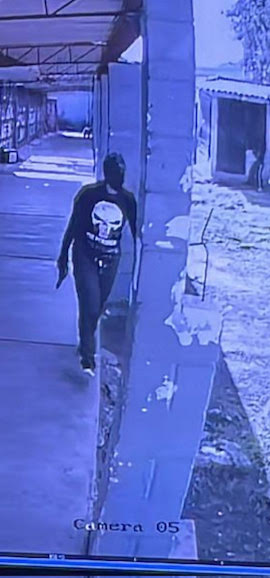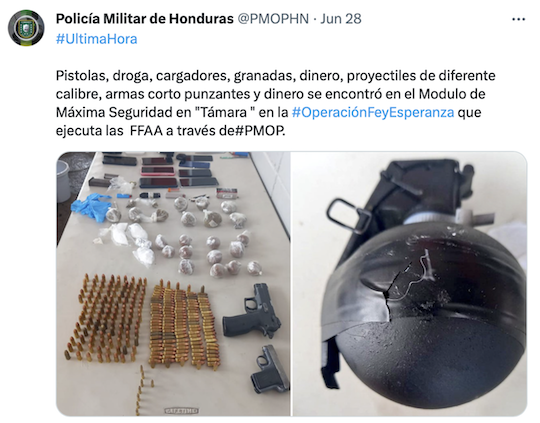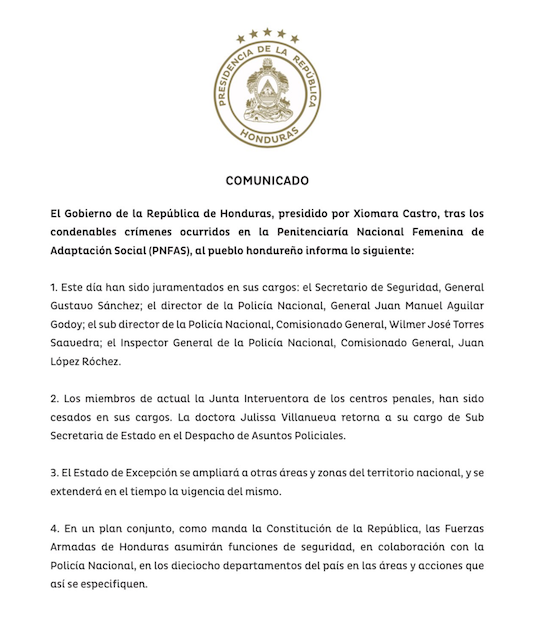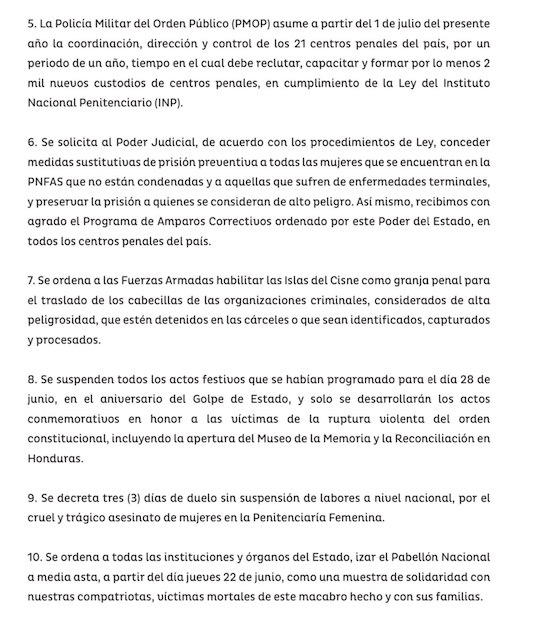Third Generation Gangs Strategic Note No. 53: Barrio 18 and MS-13 Prison Riot and Massacre in Támara Women’s Prison, Honduras

Third Generation Gangs Strategic Note No. 53: Barrio 18 and MS-13 Prison Riot and Massacre in Támara Women’s Prison, Honduras
John P. Sullivan and Robert J. Bunker
A prison riot broke out in the Women’s Prison (Centro Femenino de Adaptación Social, Támara), in Támara, Honduras on 20 June 2023. The riot, which ultimately resulted in a massacre of at least 41 inmates, started as a brawl between members of the rival Pandilla 18 (Eighteenth Street) and Mara Salvatrucha (MS-13) gangs. The part of the prison where the riot occurred burned down and was fully destroyed. An additional five persons subsequently succumbed to their wounds. In the aftermath of the incident, which has caused a national governmental crisis, the Honduran military assumed control of prisons throughout Honduras.

Female Barrio 18 Gang Member with Pistol during Támara Women’s Prison Riot/Massacre Source: Internal CCTV System, Penitenciaría Nacional Femenina de Adaptación Social (PNFAS), 20 June 2023. Image Released by the Government of Honduras.
Key Information: Emiliano Rodríguez Mega and Joan Suazo, “41 Dead After Riot Erupts in Honduran Women’s Prison.” New York Times. 20 June 2023, https://www.nytimes.com/2023/06/20/world/americas/honduras-womens-prison-riot.html:
At least 41 inmates were killed on Tuesday morning in central Honduras after a riot broke out at the country’s only prison for women, one of the deadliest outbreaks of violence in the country’s long-troubled prison system.
Most of the victims had been burned, while others had been shot, said Yuri Mora, a spokesman for the public prosecutor’s office, who added that the death toll was expected to rise as investigators combed through the detention facility in Támara, near Tegucigalpa, the capital.
While the cause of the violence was not clear, the prison has been the scene of ongoing conflict between feuding gangs…
… Killings have surged in recent years in the women’s prison, where several inmates have been strangled or stabbed during confrontations between female gang members of two rival criminal organizations: the 18th Street gang and the MS-13 gang.
Key Information: Marlon González, “Gang slaughtered 46 women at Honduran prison with machetes, guns and flammable liquid, official says AP (Associated Press). 20 June 2023, https://apnews.com/article/honduras-women-prison-riot-3df51756c946b759e2b813fa18fee7ae:
Gang members in a women’s prison in Honduras slaughtered 46 other women inmates by spraying them with gunfire, hacking them with machetes and then locking survivors in their cells and dousing them with flammable liquid, an official said Wednesday.
The carnage in Tuesday’s riot was the worst atrocity at a women’s prison in recent memory, something President Xiomara Castro called “monstrous.”
Relatives said inmates at the facility had been threatened for weeks by members of the notorious Barrio 18 gang…
… Castro said Tuesday’s riot at the prison in the town of Tamara, about 30 miles (50 kilometers) northwest of Honduras’ capital, was “planned by maras (street gangs) with the knowledge and acquiescence of security authorities.”…
… The amount of weaponry found in the prison after the riot was impressive: 18 pistols, an assault rifle, two machine pistols and two grenades — all of which were smuggled into the prison.
Key Information: Carlos S. Maldonado, “Al menos 41 muertas en una cárcel de mujeres tras un motín en Honduras.” El País. 20 June 2023, https://elpais.com/internacional/2023-06-20/al-menos-41-muertas-en-una-carcel-de-mujeres-tras-un-motin-en-honduras.html:
Un enfrentamiento entre pandillas ha causado una de las peores tragedias carcelarias en Honduras. Al menos 41 mujeres han muerto este martes en el Centro Femenino de Adaptación Social (Cefas), ha confirmado el portavoz del Ministerio Público, Yuri Mora, quien ha advertido que la cifra de víctimas puede aumentar. La presidenta Xiomara Castro ha lamentado la matanza y ha asegurado que “tomará medidas drásticas”, en un contexto en el que su Gobierno ha diseñado una política similar a la de su vecino salvadoreño Nayib Bukele para hacer frente a la violencia de las pandillas. “Conmocionada por el monstruoso asesinato de mujeres en Cefas, planificado por maras a vista y paciencia de autoridades de seguridad.”…
… Medios locales han informado que la matanza se ha producido por un enfrentamiento entre reclusas que pertenecen a las pandillas Mara Salvatrucha MS-13 y la Pandilla 18. El diario La Tribuna informa de videos que muestran a un grupo de mujeres carbonizadas. “Los cuerpos calcinados están el área de los baños y son parte de las pruebas recabadas con este lamentable hecho”, informa el periódico.[1]
Key Information: Asier Vera, “Tragedia en Honduras: mueren 46 mujeres calcinadas y a tiros en una reyerta carcelaria entre pandillas.” El Mundo. 21 June 2023, https://www.elmundo.es/internacional/2023/06/21/64922c8ce4d4d89b048b4571.html:
Las pandillas Mara Salvatrucha y Barrio 18 trasladaron su particular guerra sangrienta al Centro Femenino de Adaptación Social (Cefas) en Honduras, situado en Támara, Francisco Morazán. En esta cárcel situada a 25 kilómetros de Tegucigalpa, se produjo una reyerta este martes que provocó la muerte de al menos 46 mujeres, de las cuales 25 fallecieron calcinadas en un incendio provocado y 16 acribilladas a tiros, según datos preliminares del Ministerio Público, aunque esta cifra podría aumentar en las próximas horas, dado que al menos siete mujeres, de entre 24 y 62 años, fueron trasladadas de emergencia al Hospital Escuela situado en la capital del país, algunas con quemaduras y otras con heridas de armas de fuego y objetos contusos…
…A la espera de un reporte oficial de fallecidas por parte del Sistema Penitenciario y de una investigación judicial, los primeros indicios apuntan a que supuestamente, las pandilleras del Barrio 18 encerraron a las mujeres rivales de la Mara Salvatrucha e incendiaron el módulo uno con ellas dentro provocando una masacre. Según publica la prensa local del país, testigos han afirmado que se oían gritos de desesperación y que las reclusas atrapadas trataron de subirse por las paredes para salvarse sin éxito. Al mismo tiempo, otras reclusas se dedicaron a disparar a sangre fría a otras internas en diferentes partes del centro carcelario, tal como muestran las cámaras de seguridad de la prisión, donde se observan a mujeres armadas buscando una por una a sus objetivos para darles muerte…
…Una de las sobrevivientes, antes de ingresar al hospital, reveló cómo se produjo el ataque: “solo se metieron en el módulo con una AR-15 y, posteriormente, varias reclusas de la pandilla Barrio 18 ingresaron a las celdas”. Vecinos de Támara confirmaron a los medios locales que habían escuchado gritos de desesperación y disparos en el recinto penitenciario desde horas de la madrugada e incluso vecinos del sector compartieron en sus redes sociales vídeos de las columnas de humo que salían de la prisión.
Una de las primeras en confirmar que había presas muertas en el interior del penal fue Telma Ordóñez, presidenta de la Asociación de Familiares de Privados de Libertad, quien reveló que las autoridades de la cárcel habían informado a las reclusas que quien tuviera negocios dentro de la prisión se los iban a quitar, al tiempo que les iban a retirar televisores, equipos electrónicos y microondas, lo que generó un malestar. “No era la forma, pero fueron las acciones que tomaron”, explicó, al tiempo que desveló que “mataron tres mujeres que estaban en maternidad y cinco personas de la panadería y quemaron un módulo complete”.[2]
Key Information: “Matanza en PNFAS: encuentran un arsenal al interior de la cárcel de mujeres de Támara.” El Heraldo (Honduras). 21 June 2023, https://www.elheraldo.hn/honduras/encuentran-arsenal-perpetro-matanza-carcel-mujeres-pnfas-cefas-tamara-honduras-IG14031768:
Un arsenal fue encontrado por autoridades policiales al interior de una cárcel de mujeres de Honduras, donde ocurrió una matanza que dejó como saldo al menos 41 reclusas muertas y varias más heridas.
Informes preliminares indican que la reyerta mortal inició por un pleito entre dos estructuras criminales en la Penitenciaria Nacional Femenina de Adaptación Social (PNFAS).
Integrantes de la Pandilla 18 habrían atacado el módulo 1 del recinto, donde estaban recluidas miembros de la MS-13. Allí encerraron en un cuarto a sus rivales y les prendieron fuego, resultando 25 privadas de libertad calcinadas…
…Autoridades policiales encontraron al interior del centro penal un arsenal de armas, entre las que se incluye una mini uzi, varias pistolas y un fusil de asalto.[3]
Key Information: “Honduran armed forces seize control of prisons to stamp out gangs.” Al Jazeera. 26 June 2023, https://www.aljazeera.com/news/2023/6/26/honduran-armed-forces-seize-control-of-prisons-to-stamp-out-gangs:
The government of Honduras has announced a crackdown on organised crime within the Central American country’s prison system after an attack in a women’s penal centre left 46 people dead last week.
The Honduran Armed Forces said on Monday that their push “to regain control of the prisons” had begun, dubbing the initiative “Operation Faith and Hope”.
Searches were under way on Monday morning at the Tamara Penal Centre, where the armed forces said they had recovered high-calibre weapons, grenades, ammunition, cell phones and devices for internet access within the prison walls.
The initial search appeared to focus on the men’s prison, though Tamara was also the site of last week’s deadly attack in the Centro Femenino de Adaptacion Social (CEFAS), a women’s detention centre that can house approximately 900 people…
…Re-militarising the prison system
Castro promised to take “drastic action” in the wake of the prison clash. Last week, she announced that control of 21 of the country’s 26 prisons would revert to the Military Police of Public Order (PMOP), in an attempt to suppress organised crime.
It was a dramatic about-face for an administration that had once sought to demilitarise certain aspects of public security. Last year, Castro had removed the prisons from PMOP authority, putting them instead under the national police.
Third Generation Gangs Analysis
The riot/massacre at the women’s prison— Penitenciaría Nacional Femenina de Adaptación Social (PNFAS)—in Támara, Honduras is the latest gang-related atrocity to confront that nation. The incident occurred during an existing Estado de excepción (State of exception), that was initiated on 6 December 2022 and subsequently extended.[4] This barbaric attack was begun by female Barrio 18 gangsters (aka Pandilla 18 or the Eighteenth Street gang) locking rival female Mara Salvatrucha MS-13 inmates in their module and then setting the module on fire. This was accompanied by other killings that utilized a range of weapons including pistols and an assault rifle. While not mentioned in news reports, fragmentation grenade use would also be expected given the gang arsenals drawn upon (which were seized by Honduran authorities post-incident).
The riot/massacre ultimately resulted in 46 deaths, the removal of prison officials, and transfer of prison control for one year to military police (under the Fuerzas Armadas de Honduras–FFAA). The President’s mandate stated:
“La Policía Militar del Orden Público (PMOP) asume a partir del 1 de julio del presente año la coordinación, dirección y control de los 21 centros penales del país, por un periodo de un año, tiempo en el cual debe reclutar, capacitar y formar por lo menos 2 mil nuevos custodios de centros penales, en cumplimiento de la Ley del Instituto Nacional Penitenciario (INP)”[5]
This is not the first serious prison riot between Barrio 18 and MS-13. On 20 June 2021, exactly two years earlier than this this incident, a prison riot between Barrio 18 and MS-13 at the ‘La Tolva’ (men’s) maximum security prison left five dead and 39 injured [6]. Barrio 18 also initiated that prison riot, suggesting that the anniversary date is likely not a coincidence. These two rival transnational gangs are competing for power in the prisons and on the streets of Honduras and may contribute to celebrate past victories against one another with more blood being spilled.
A copy of the Presidential Comunicado outlining the transfer of control for prison security follows the two Tweets below. Collectively, these communications summarize the depth of the prison-street gang complex found in Honduras (and other parts of Latin America) where gangs exercise territorial control through a combination of activities in prison and on the streets.[7] As witnessed by the incident—and the sheer amount of weaponry and other contraband recovered post-incident from the facility—a thriving illicit economy exists within Támara women’s prison with actual state control tentative at best. The alternative governance that Barrio 18 and MS-13 have mutually established in the Honduran penal system is both a direct challenge to federal authority (via the concept of “carceral sovereignty”) and a catalyst for ongoing violent conflict in what should be considered “a key institution of state control.”[8]

Guns, drugs, chargers, grenades, money, projectiles of different calibers, sharpened short weapons and money were found in the Maximum Security Module in “Támara” in #OperaciónFeyEsperanza that the Armed Forces execute through #PMOP Source: Policía Militar de Honduras. @PMOPHN. 28 June 2023, https://twitter.com/PMOPHN/status/1674026374313418754?s=20


Statement of President Xiomara Castro Dismissing Prison Officials, Extending State of Exception, and Transferring Security Functions to the Armed Forces in Collaboration with the National Police in the Aftermath of the Penitenciaría Nacional Femenina de Adaptación Social (PNFAS) Massacre.[9]
Sources
Marlon González, “Gang slaughtered 46 women at Honduran prison with machetes, guns and flammable liquid, official says.” AP (Associated Press). 20 June 2023, https://apnews.com/article/honduras-women-prison-riot-3df51756c946b759e2b813fa18fee7ae.
“Honduran armed forces seize control of prisons to stamp out gangs.” Al Jazeera. 26 June 2023, https://www.aljazeera.com/news/2023/6/26/honduran-armed-forces-seize-control-of-prisons-to-stamp-out-gangs.
Carlos S. Maldonado, “Al menos 41 muertas en una cárcel de mujeres tras un motín en Honduras.” El País. 20 June 2023, https://elpais.com/internacional/2023-06-20/al-menos-41-muertas-en-una-carcel-de-mujeres-tras-un-motin-en-honduras.html.
Pamela Pino, “‘Recobraremos el control de centros penales’, afirma el comandante de la Policía Militar.” El Heraldo (Honduras). 22 June 2023, https://www.elheraldo.hn/honduras/recobraremos-control-centros-penales-comandante-policia-militar-PD14066823.
“Matanza en PNFAS: encuentran un arsenal al interior de la cárcel de mujeres de Támara.” El Heraldo (Honduras). 21 June 2023, https://www.elheraldo.hn/honduras/encuentran-arsenal-perpetro-matanza-carcel-mujeres-pnfas-cefas-tamara-honduras-IG14031768
Emiliano Rodríguez Mega and Joan Suazo, “41 Dead After Riot Erupts in Honduran Women’s Prison.” New York Times. 20 June 2023, https://www.nytimes.com/2023/06/20/world/americas/honduras-womens-prison-riot.html.
Asier Vera, “Tragedia en Honduras: mueren 46 mujeres calcinadas y a tiros en una reyerta carcelaria entre pandillas.” El Mundo. 21 June 2023, https://www.elmundo.es/internacional/2023/06/21/64922c8ce4d4d89b048b4571.html.
Endnotes
[1] In English, the title reads: “At least 41 dead in women’s prison after riot in Honduras.”
The text reads: “A confrontation between gangs has caused one of the worst prison tragedies in Honduras. At least 41 women died on Tuesday in the Women’s Center for Social Adaptation (Cefas), confirmed the spokesman for the Public Ministry, Yuri Mora, who warned that the number of victims could rise. President Xiomara Castro has lamented the massacre and assured that she “will take drastic measures”, in a context in which her government has designed a policy similar to that of her Salvadoran neighbor Nayib Bukele to deal with gang violence. “Shocked by the monstrous murder of women in Cefas, planned by gangs in full view of security authorities.” […] Local media have reported that the killing was caused by a confrontation between inmates belonging to the Mara Salvatrucha MS-13 and Gang 18 gangs. La Tribuna newspaper reports videos showing a group of charred women. ‘The charred bodies are in the bathroom area and are part of the evidence collected with this unfortunate event,’ the newspaper reports.”
[2] In English, the title reads: “Tragedy in Honduras: 46 women shot and burned to death in prison gang brawl.” The text reads: “The Mara Salvatrucha and Barrio 18 gangs moved their particular bloody war to the Women’s Social Adaptation Center (Cefas) in Honduras, located in Támara, Francisco Morazan. In this prison located 25 kilometers from Tegucigalpa, a brawl took place on Tuesday that resulted in the death of at least 46 women, of which 25 burned to death in an arson attack and 16 shot to death, according to preliminary data from the Public Ministry, although this figure could increase in the coming hours, since at least seven women, aged between 24 and 62 years, were transferred to the Hospital Escuela located in the capital of the country, some with burns and others with gunshot wounds and blunt objects. […] While awaiting an official death toll report from the prison system and a judicial investigation, initial indications are that Barrio 18 gang members allegedly locked the rival Mara Salvatrucha women inside and set fire to module one, causing a massacre. According to the country’s local press, witnesses said they could hear cries of desperation and that the trapped inmates tried to climb the walls to save themselves without success. At the same time, other inmates were shooting in cold blood at other inmates in different parts of the prison, as shown by the prison’s security cameras, where armed women can be seen looking for their targets one by one to kill them. […] One of the survivors, before being admitted to the hospital, revealed how the attack took place: ‘They just went into the module with an AR-15 and then several inmates from the Barrio 18 gang entered the cells.’ Neighbors of Tamara confirmed to local media that they had heard cries of despair and gunshots in the prison since the early hours of the morning, and even neighbors of the sector shared on their social networks videos of the plumes of smoke coming out of the prison. […] One of the first to confirm that there were dead inmates inside the prison was Telma Ordóñez, president of the Association of Relatives of Prisoners, who revealed that the prison authorities had informed the inmates that whoever had business inside the prison would have it taken away, at the same time that they were going to take away televisions, electronic equipment and microwaves, which generated uneasiness. ‘It was not the way, but those were the actions they took,’ he explained, while revealing that ‘they killed three women who were in maternity and five people from the bakery and burned an entire module.’”
[3] In English, the title reads: “Slaughter in PNFAS: arsenal found inside Támara women’s prison.” The text reads: “Police authorities found an arsenal of weapons inside a women’s prison in Honduras, where a massacre occurred that left at least 41 inmates dead and several more injured. […] Preliminary reports indicate that the deadly brawl started because of a fight between two criminal structures in the Penitenciaria Nacional Femenina de Adaptación Social (PNFAS). […] Members of Pandilla 18 allegedly attacked Module 1 of the facility, where MS-13 members were being held. There, they locked their rivals in a room and set fire to them, resulting in 25 inmates being burned. […] Police authorities found inside the prison an arsenal of weapons, including a mini uzi, several pistols and an assault rifle.”
[4] The Estado de excepción proclaimed by President Xiomara Castro echoes that imposed in El Salvador by President Nayib Bukele. See Helen Montoya, “Honduras Makes Few Advances Against Crime During 6-Month State of Exception.” InSight Crime. 5 June 2023, https://insightcrime.org/news/honduras-makes-few-advances-against-crime-during-6-month-state-of-exception/; Héctor Silva Avalos, “States of Exception: The New Security Model in Central America?” WOLA (Washington Office on Latin America), 22 February 2023, https://www.wola.org/analysis/states-of-exception-new-security-model-central-america/; and Pamela Ruiz, “Security at the Expense of Constitutional Guarantees: The Case of Honduras.” Small Wars Journal. 6 February 2023, https://smallwarsjournal.com/jrnl/art/security-expense-constitutional-guarantees-case-honduras.
[5] In English, the text reads; “The Military Public Order Police (PMOP) assumes, as of 1 July of this year, the coordination, direction and control of the 21 prisons in the country, for a period of one year, during which time it must recruit, train and educate at least 2 thousand new prison guards, in compliance with the Law of the National Penitentiary Institution (INP).” See Pamela Pino, “‘Recobraremos el control de centros penales’, afirma el comandante de la Policía Militar.” El Heraldo (Honduras). 22 June 2023, https://www.elheraldo.hn/honduras/recobraremos-control-centros-penales-comandante-policia-militar-PD14066823.
[6] John P. Sullivan and Robert J. Bunker, “Third Generation Gangs Strategic Note No. 39: Five Killed in Prison Battle between Barrio 18 and MS-13 in La Tolva Prison, Honduras.” Small Wars Journal. 20 June 2021, https://smallwarsjournal.com/jrnl/art/third-generation-gangs-strategic-note-no-39-five-killed-prison-battle-between-barrio-18.
[7] On prison-street gang complexes, see John P. Sullivan and Nathan P. Jones, “Bandits, Urban Guerrillas, and Criminal Insurgents: Crime and Resistance in Latin America” in Pablo A. Baisotti, Ed., Problems and Alternatives in the Modern Americas, pp. 168-195. New York: Routledge, 2021.
[8] See Paul Rexton Kan, “Busted: The Micropower of Prisons in Narco-States.” Small Wars Journal. 5 December 2016, https://smallwarsjournal.com/jrnl/art/busted-the-micropower-of-prisons-in-narco-states. This is due to the fact that Honduras is a relatively poor ‘low political capacity’ state. While criminal gang activity in the United States is a manageable social and policing problem, in Central American states, such as Honduras, it can quickly be elevated to a national security and military concern—especially when Third Generation Gangs (3GEN Gangs) are involved.
[9] Text Of the Presidential Comunicado in English: “The Government of the Republic of Honduras, presided by Xiomara Castro, after the condemnable crimes that have occurred in Honduras, informs the Honduran people of the following: 1. The following have been sworn in today: the Secretary of Security, General Gustavo Sánchez; the Director of the National Police, General Juan Manuel Aguilar Godoy; the Deputy Director of the National Police, Commissioner General, Wilmer José Torres
Torres Saavedra; the Inspector General of the National Police, Commissioner General, JuanLópez Róchez. 2. The members of the current Board of Controllers of the penitentiary centers have been dismissed from their posts, have been dismissed from their positions. Dr. Julissa Villanueva returns to her position as Deputy Secretary of State in the Office of the Attorney General, Secretary of State in the Office of Police Affairs. 3. The State of Exception will be extended to other areas and zones of the national territory, and the duration of the State of Exception will be extended to other areas and zones of the national territory, and will be extended to other areas and zones of the national territory, and its validity will be extended in time. 4. In a joint plan, as required by the Constitution of the Republic, the FFAA [Armed Forces of Honduras] shall assume security functions, in collaboration with the National Police, in the eighteen departments of the country in the areas and actions as specified. 5. PMOP [La Policía Militar del Orden Público] assumes, as of 1 July, the coordination, direction and control of the 21 penitentiary centers in the country, for 1 year. In compliance with the Penitentiary Institute Law, at least 2,000 new prison guards must be recruited, trained and educated in one year. 6. The Judicial Branch is requested; The Judiciary is requested, in accordance with the procedures of the Law, to grant alternative measures to preventive detention to all women in the PNFAS who are not convicted and to those who suffer from terminal illnesses, and to preserve the imprisonment of those who are considered to be in high danger. 7. The Armed Forces are ordered to enable the Cisne [Swan] Islands as a penal farm for the transfer of the leaders of criminal organizations, considered to be highly dangerous. 8. All festive events scheduled for June 28 (anniversary of the coup d’état) are suspended and only commemorative events in honor of the victims of the violent rupture of the constitutional order will be held, including the opening of the Museum of Memory and Reconciliation in Honduras. 9. Three (3) days of mourning without suspension of work at national level are decreed, due to the cruel and tragic murder of women in the Women’s Penitentiary.
10. All the institutions and organs of the State are ordered to hoist the National Flag at half mast, starting on Thursday, 22 June, in solidarity with the compatriots, mortal victims of this macabre act and their families. Tegucigalpa, 21 June, two thousand twenty-three (2023). CASA PRESIDENCIAL/PRESIDENTIAL HOUSE
For Additional Reading
John P. Sullivan and Robert J. Bunker, “Third Generation Gangs Strategic Note No. 39: Five Killed in Prison Battle between Barrio 18 and MS-13 in La Tolva Prison, Honduras.” Small Wars Journal. 20 June 2021.
John P. Sullivan and Robert J. Bunker, Eds., Strategic Notes on Third Generation Gangs. Bloomington, IN: Xlibris, 2020.
John P. Sullivan, Robert J. Bunker, and Juan Ricardo Gómez Hecht. “Third Generation Gangs Strategic Note No. 29: Mara Salvatrucha (MS-13) Attacks Honduran Prison Guards with Grenades and Assault Rifles.” Small Wars Journal. 31 July 2020.
Paul Rexton Kan, “Busted: The Micropower of Prisons in Narco States.” Small Wars Journal. 5 December 2016.






